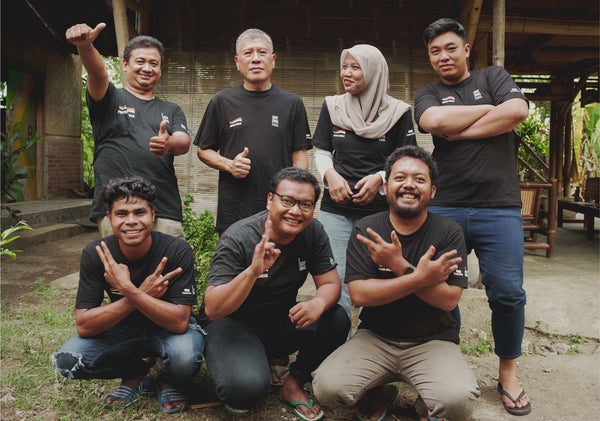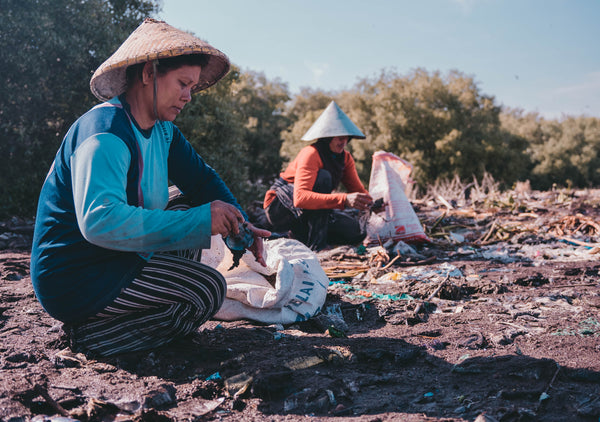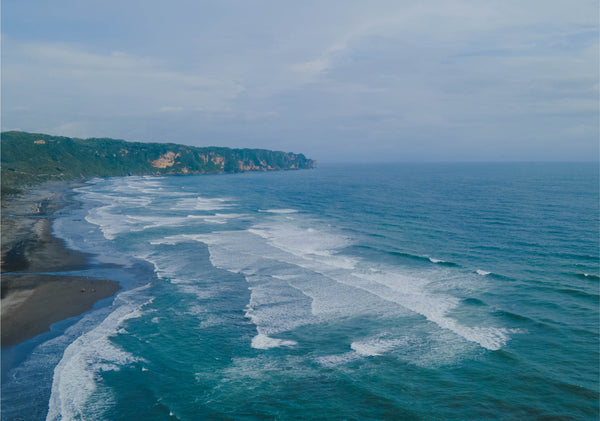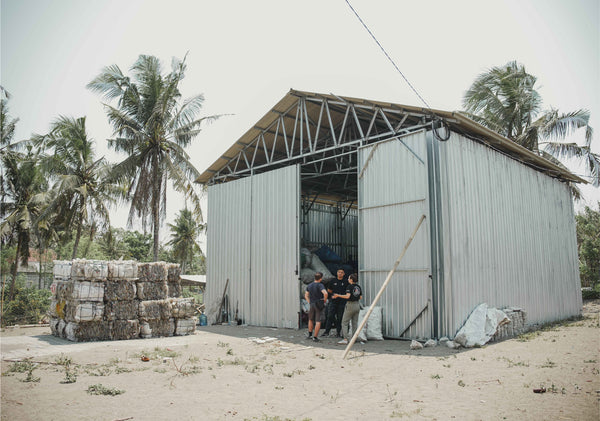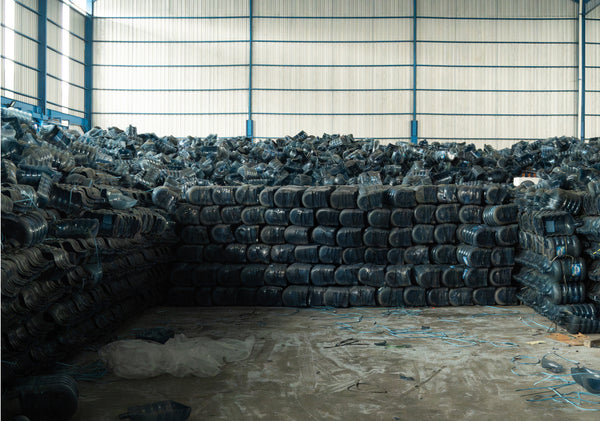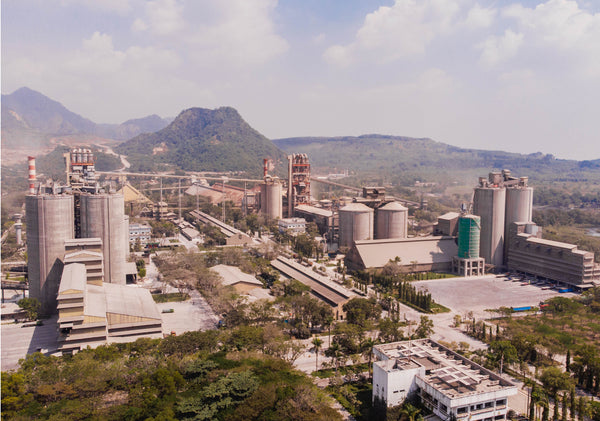PRO PACK
SUPPLY CHAIN
NGO Yayasan Got Bag Indonesia Office, in Yogyakarta, Indonesia
Coordinating and running of the clean-up program
Our partner foundation, Yayasan GOT BAG Indonesia, operates a clean-up program focused on collecting plastic waste. In addition, the foundation concentrates on education and expanding the waste management system to comprehensively address the issue of ocean plastic pollution. We are in regular communication with the eight full-time employees of Yayasan GOT BAG Indonesia. Our Lead of Mission, Leonie, visits the organization several times a year to work closely with the Indonesian team and the collection communities. She reviews progress and collaborates with the team on decisions regarding additional projects.
Clean-up Communities, in Bantul, Indonesia
Plastic waste collection
The clean-up program began in Demak on the north coast of Java. This Indonesian region is located at the mouth of several rivers, transporting large amounts of plastic waste from the island’s mainland to the sea. GOT BAG Indonesia now has enlarged its program to the regions of Jepara in the north and Bantul on the south coast. The clean-up program includes fishermen and other collectors who collect plastic from the sea, mangrove regions, and coastal areas, like delta regions with rivers. At the Collection Points, villagers who do not have a functioning waste management system can also dispose of their household plastic waste. Additionally, we rely on our recycling partner's plastic collection network which is Ocean Bound Plastic certified.
Clean-up Communities, in Demak, Indonesia
Plastic waste collection
The clean-up program began in Demak on the north coast of Java. This Indonesian region is located at the mouth of several rivers, transporting large amounts of plastic waste from the island’s mainland to the sea. GOT BAG Indonesia now has enlarged its program to the regions of Jepara in the north and Bantul on the south coast. The clean-up program includes fishermen and other collectors who collect plastic from the sea, mangrove regions, and coastal areas, like delta regions with rivers. At the Collection Points, villagers who do not have a functioning waste management system can also dispose of their household plastic waste. Additionally, we rely on our recycling partner's plastic collection network which is Ocean Bound Plastic certified.
Clean-up Communities, in Jepara
Plastic waste collection
The clean-up program began in Demak on the north coast of Java. This Indonesian region is located at the mouth of several rivers, transporting large amounts of plastic waste from the island’s mainland to the sea. GOT BAG Indonesia now has enlarged its program to the regions of Jepara in the north and Bantul on the south coast. The clean-up program includes fishermen and other collectors who collect plastic from the sea, mangrove regions, and coastal areas, like delta regions with rivers. At the Collection Points, villagers who do not have a functioning waste management system can also dispose of their household plastic waste. Additionally, we rely on our recycling partner's plastic collection network which is Ocean Bound Plastic certified.
Warehouse, in Jepara
Plastic waste sorting, cleaning, baling, and storage
All recyclable types of plastic (e.g., PET, PP, HDPE, LDPE) that have been handed in by the collectors from the communities are then taken to the foundation's warehouse in Bantul or Jepara. There, the staff manually sort the material by specific types of plastic and colors, removing labels and caps. The sorted and processed plastic is then compressed into cube-shaped bales by a machine. These bales are subsequently transported to relevant partners in the region for mechanical recycling.
Warehouse, in Bantul, Indonesia
Plastic waste sorting, cleaning, baling, and storage
All recyclable types of plastic (e.g., PET, PP, HDPE, LDPE) that have been handed in by the collectors from the communities are then taken to the foundation's warehouse in Bantul or Jepara. There, the staff manually sort the material by specific types of plastic and colors, removing labels and caps. The sorted and processed plastic is then compressed into cube-shaped bales by a machine. These bales are subsequently transported to relevant partners in the region for mechanical recycling.
PET Recycling Partner Surabaya, on Java, Indonesia
PET recycling for the production of the RE:PET fabric
The PET bottles collected and processed by GOT BAG Indonesia’s collection communities are sent to our recycling partner in Surabaya. There, the material is shredded, washed again, dried, melted, filtered, and extruded into rPET pellets. In addition to the PET bottles collected through the clean-up program, we also source Ocean Bound Plastic certified PET through our recycling partner on Java.
Certificates: Ocean Bound Plastic, Global Recycled Standard
RE:PC Recycler, on Java, Indonesia
Source of recycled polycarbonate
RE:PC is recycled polycarbonate material made from discarded water dispenser containers. These containers are not collected through the GOT BAG Indonesia clean-up program, as they are typically part of an exchange system. Instead, we source these materials from our recycling partner in Indonesia, who collects them within a 50 km range from the coast, primarily from restaurants or businesses that use water dispenser stations. The recycled polycarbonate we use for our RE:PC is Ocean Bound Plastic certified and is a lightweight, durable material, ideal for luggage cases and sunglasses.
Certificates: Ocean Bound Plastic, Global Recycled Standard
RE:NYNET® Supplier, in Taiwan
Source of recycled nylon
RE:NYNET® is a recycled nylon fabric made from discarded fishing nets. We source this material through our partner and yarn spinner, Formosa Chemicals & Fibre Corporation in Taiwan. We use RE:NYNET® for products that benefit from its soft, lightweight, yet durable properties.
Certificates: SGS, ISO 45001:2018, ISO 14001:2015, ISO 9001:2015, Global Recycled Standard, bluesign System Partner
Recycling partners, on Java, Indonesia
Mechanical recycling of recyclable plastic except PET
For some types of recyclable plastics that we cannot use for products ourselves, such as PP, HDPE, LDPE, etc., the foundation GOT BAG Indonesia is continuously expanding its network with locally based companies that can mechanically recycle them. They are processed into so-called secondary raw materials before they can be used for other products.
Cement Plant, on Java, Indonesia
Partner for incineration of non-recyclable plastic waste for energy production
A large portion of the plastic waste collected by GOT BAG Indonesia consists of non-recyclable multilayer compounds or plastic that has been too heavily degraded by sun and saltwater to be mechanically recycled. Many of these plastic materials are of insufficient quality or can only be recycled with disproportionate effort. Currently, we pass these materials on for thermal utilization, where they are used as an alternative to fossil fuels for energy production.
Spinning mill, near Taipei, Taiwan
Yarn production for RE:PET fabric
We spin from the rPET pellets so-called filament yarn in a partner’s spinning mill. The base yarn is 300 Denier which means that a 9,000-meter-long thread weighs 300 grams. The yarn is extruded almost endlessly from the melted PET. After extrusion, the yarn is stretched to become strong enough for later weaving. For black fabrics, we dye the yarn already with extrusion spinning – this dyeing process does not require any water or solvents. Additionally, it is advantageous that the spin-dyed yarn has an extremely high color fastness.
Certificates: Ocean Bound Plastic, Global Recycled Standard
Weaving mill, near Taipei, Taiwan
Weaving, dyeing, and coating of the RE:PET and RE:NYNET fabric
The yarn is woven into a particularly robust 600D or a lighter 300D Oxford fabric at a weaving mill. For this, the best yarn qualities (AA) are selected for the warp yarn since the requirements for tensile strength are highest for dense weaving. All black products are usually yarn-dyed (spin-dyed). This means that black color pigments are added to the yarn during spinning. This eliminates the need for the usual wet dyeing process. For all non-black products, we dye the textile directly after weaving with dispersion dyes in a nearby dyeing mill. We avoid dyeing and additives that are on a negative list (e.g., from Ökotex, Bluesign or ZDHC). After dyeing, the fabrics are - for waterproof welding - coated with a thin TPU layer of about 0.15 mm on the backside. A very thin permanent water-repellent finish with PU is applied to the outside of the fabric.
All fabrics for sewn products only receive a thin waterproof PU layer on the back and a PFC-free DWR is added on the outside.
Certificates: ISO 45001:2018, ISO 14001:2015, ISO 9001:2015, Global Recycled Standard, bluesign System Partner
Cut, Make, Trim in Jepara, Indonesien
Cutting and welding of RE:PET products
For our waterproof products the construction is high-frequency welding. For high-frequency welding, the materials are cut to size beforehand and then welded with specially-made molds in the high-frequency machines. For this, the TPU material at the welding seams - and only there - is melted with an electromagnetic alternating field of about 27 MHz and joined together by the pressure of a press. The seams are then 100% waterproof and of very high strength.
Our products do not consist exclusively of the main fabric – additional product-specific accessories such as buckles, zippers, straps, foams, and webbing are added. As far as possible, these components are made from recycled materials, although some are not yet available on the market.
Certificate: Recycled Claim Standard
Cut, Make, Trim in Ho Chi Minh City region, Vietnam
Cutting and stitching of our sewn RE:PET products
For the sewn products, we use fabrics without TPU coating. The cut fabric parts are sewn and locked with special sewing machines for backpacks. We exclusively manufacture sewn products in Vietnam in the Ho Chi Minh City region.
Our products do not consist exclusively of the main fabric – additional product-specific accessories such as buckles, zippers, straps, foams, and webbing are added. As far as possible, these components are made from recycled materials, although some are not yet available on the market.
Certificates: Global Recycled Standard, Recycled Claim Standard, FairWear audited, ISO 19001:2015
Sunglasses production in Zhejiang region, China
Manufacturing of RE:SHADES
Our recycling partner provides the RE:PC used to produce the frames for our RE:SHADES sunglasses. Additional components, such as lenses made from recycled post-industrial polycarbonate.
Certificates: Global Recycled Standard
Luggage production, in the Shanghai region, China
Manufacturing of RE:PC luggage
Our recycling partner supplies the RE:PC material used to produce the hard-shell cases for our RE:SHELL luggage. The shells are formed through vacuum thermoforming. Additional components are sourced and assembled to complete the production process of the luggage.
Certificates: Global Recycled Standard
Warehouse for shipping products in Europe
in Bischofsheim, Germany
Warehouse for delivery in the United States
in Portland, North America
Headquarter
in Mainz, Germany
Over 70 employees are part of the GOT BAG team. Our office has been located in the capital of Rhineland-Palatinate, Mainz, since our founding.
Office USA
in Keizer, Oregon
Our US team is located in Keizer, OR.
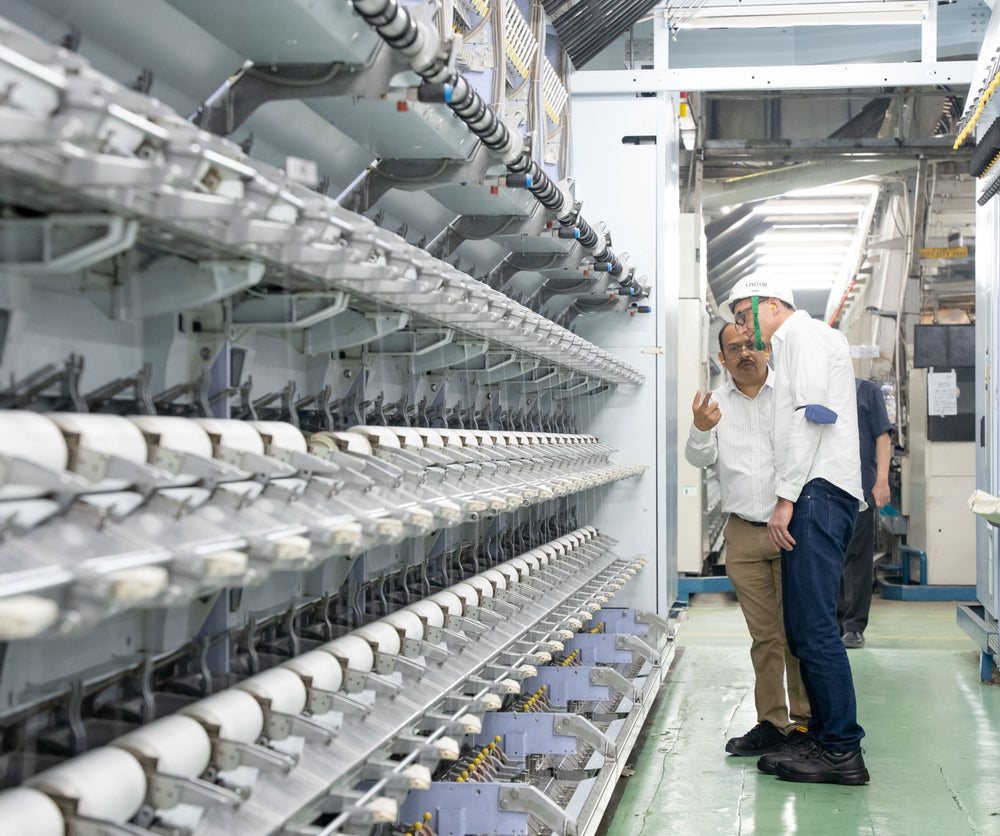
At GOT BAG, we strive to create a positive impact on our oceans together with our partners. Our commitment to effective environmental and social standards is essential to achieving this goal.
Our Code of Conduct outlines the responsibilities we share for people, global societies, and the environment. All our suppliers are committed to adhering to our Code of Conduct.
View our Code of Conduct here:
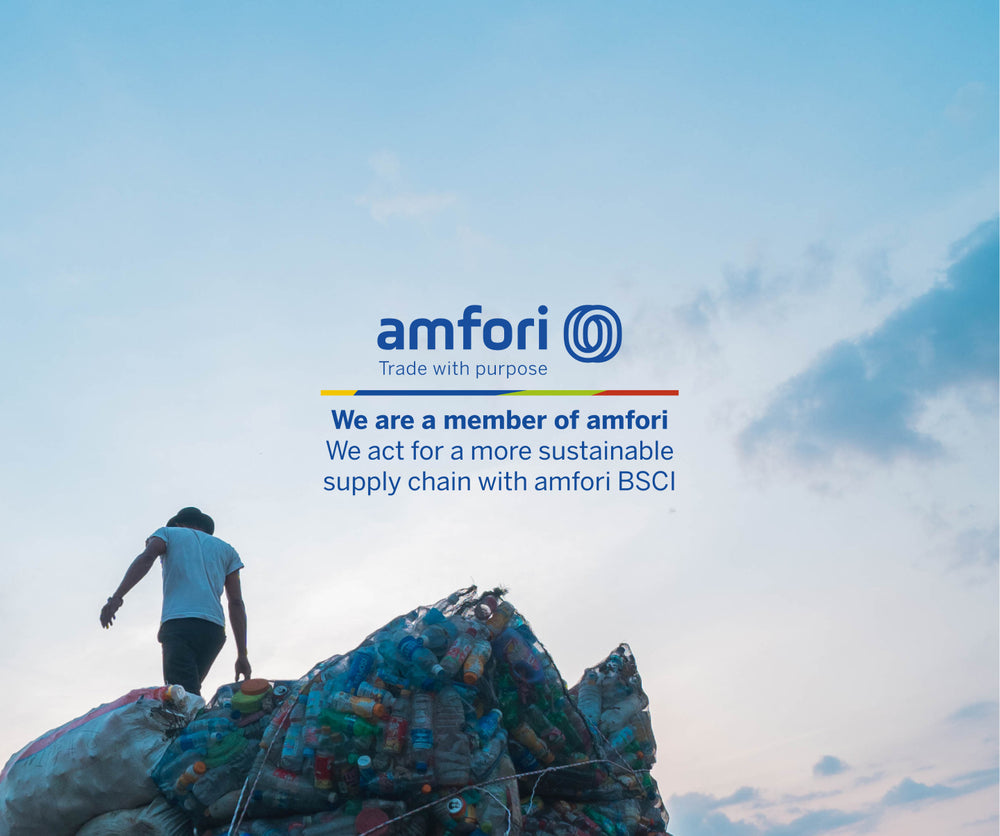
amfori BSCI (Business Social Compliance Initiative) is a comprehensive programme designed to identify, assess, and mitigate social risks within supply chains.
amfori BSCI enables us to exercise ESG due diligence, enhance transparency, and address significant violations of working conditions within international labour rights frameworks.




